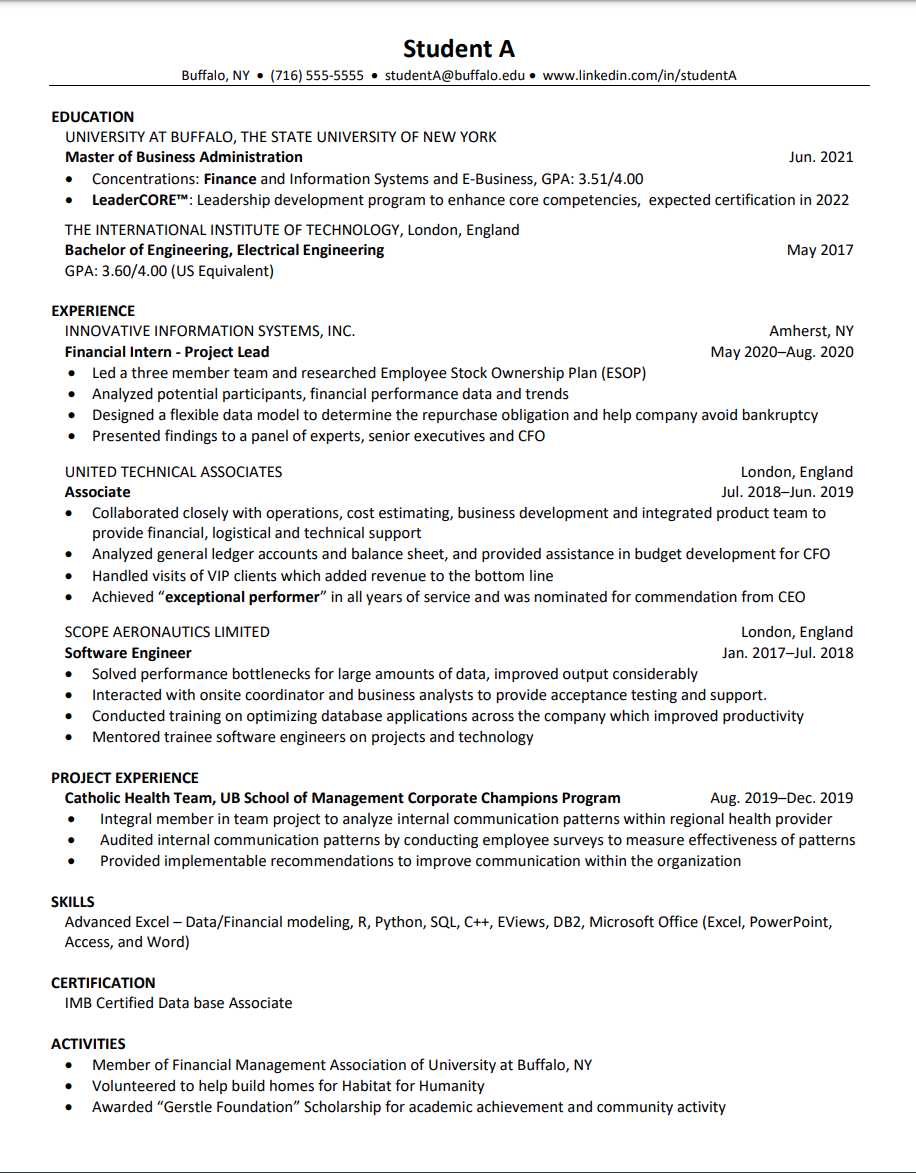MBA Resume Writing Style & Examples for Your 2024 Application

So, you’re looking to apply to an MBA program, and you’ve heard that your packet needs a resume. If you've come out of your bachelor’s program, and you don’t have one, or maybe you already know that your current resume . Either way, you need to find out what to do next, and that’s why you’re here.
As you may know, an MBA resume is significantly different from an employment resume. But how do you write one? And why is it important? The answer to both of these, depends on whom you’re writing to and what you’re selling. With an employment resume, you’re looking to express your expertise for the role. With MBA admissions, you’re applying to show your potential as a future business leader.
This means adding things you wouldn’t normally add to a standard resume and leaving out things you would normally keep. But don’t worry, it’s not a totally new science.
Take a look at what an MBA resume is, how to write one, and an example of a good one, and it’ll soon become clear to you what needs to be done to stand out.
What is an MBA Resume?
An MBA resume is a tailored account of your employment history and experience for a Master’s in Business Administration degree.
All MBA application departments require one, and plenty of people make the mistake of thinking their standard resume is suitable. This can be a very costly mistake, as admissions officers will likely not find what they're looking for in a poorly tailored within seconds of looking at it.
An MBA resume is more than just a history of your experience in the field. It needs to demonstrate not only professional and educational accomplishments but examples of leadership skills and similar applicable qualities for the course. It’s also a more concise and specific example of a resume than the one you might write for a job offer.
There are similarities between employment resumes and MBA resumes, but with a specific target audience and vast amounts of competition, it’s critical to know how to break through the body of applicants to make yourself stand out. You may have all the necessary qualities for the role, but if your resume flops, nobody will ever notice, and none of these qualities will matter.
Writing an MBA resume is an important skill to learn before applying, and it all starts with knowing how it differs from a regular resume.

Differences Between Resume for MBA Application and for Employment
The key differences between an MBA resume and a resume for the working world are related to the difference in audiences for both. Any resume can only be successfully written by keeping the audience in mind, and an admissions officer is a different target than a potential employer.
Admissions officers are likely going to be experts in their own field, but they’re not necessarily going to be experts in yours. Therefore, your resume must communicate a general understanding of the specific topic you’re versed in. While applying for a job requires you to establish yourself as knowledgeable about the role with detailed information, writing an MBA resume should appeal to a more general audience. Please explain what you know, but do so straightforward, accessible language.
While an employment resume might benefit from a list of technical job descriptions, an MBA resume should be able to turn these descriptions into a more management-focused summary of your skills and potential, leading with actions and showing results.
A resume for MBA application should also be tailored to express your potential a lot more than a job application should. Employers usually expect you to know your stuff, and they want to spend as little on training you for the role as possible.
On the contrary, an MBA is there to expand upon your talents and provide a strong educational advantage. However, they’re not looking to start from scratch either – you need to show that you can make the most of the education they’re offering you.
How to Write an MBA Resume
To expand upon the previous section, writing a resume for MBA programs needs to demonstrate your communication ability. Communication is a skill that will be useful in the classroom, so an admissions officer will be looking for someone who can explain their field to people who are involved in different disciplines and may not know much about it.
Jargon needs to be cut, and in its place, simple, easy-to-understand terminology should be chosen. How clear you make your resume is the first demonstration of your potential for the course. What you’re trying to do is show your understanding of your field by simplifying and summarizing it for others.
At the same time, remember that you’re writing to someone who has seen hundreds of resumes. If your career path is one of the more standard options, there’s no need to repeat the basics. Instead, put more work into the elements of your experience that are particular to you and stand out.
Aside from whom you’re selling to, another significant difference is what you’re selling. Keeping in mind how important it is to be concise in an MBA resume, you’re going to have to describe your specific accomplishments in simple language with a strong focus on leadership.
To do this, focus first on the project, then mention the actions you took, and follow up with the results of your success.
Leadership should be one of the major focuses of an MBA resume. Still, the whole document should essentially be one page, separated into at least three categories: Professional experience, Education, and Additional information. So, let’s break it down.
What to Include
The professional section of your MBA resume will include a quantified summary of your professional achievements. Highlight your strengths in bullet points, and separate each section by job title or role, alongside location and date. This should be familiar since it’s very similar to a standard work resume.
As with the rest of the resume, your education section should be short and to the point. At this stage, it should only contain your undergrad university, your degree, and your major, along with your GPA. If your high school was particularly prestigious, it might be worth a mention, but usually, applications will only be looking at your higher education.
For additional information, you can include specific skills that you think might be relevant but aren’t mentioned in the previous sections. Any impressive certifications or extra activities that might catch the eye of admissions can also fit into this part. Again, make it concise and to the point.
Extracurriculars can be a valuable addition unless they’re too plentiful and too similar to one another. Include aspects of yourself that show versatility and outside interests, but don’t go too far with long lists.
What to Leave Out
With the importance of being concise, knowing what to leave out of an MBA resume is necessary as knowing what to put in one. Broken down into the same sections, here’s what not to do:
Don’t make a technical job description for your professional experience. You’re looking to identify specific qualities and quantify them, so don’t just list everything you did in your previous roles. We’ll talk more about this in the formatting section, but essentially, don’t flood the page with useless information about your job description that is irrelevant to the admissions officer.
Don’t list every extra-curricular you can think of with the education section, and don’t mention your high school. As usual, redundant information will work strongly against you in this resume.
Don’t include every on-the-job certification either. Remember that space is limited, and professional certifications are mostly subjective to the company employing you, so only include recognizable and accredited certifications that your admissions officer will respect.

How to Format Your MBA Resume
Remember that an admissions officer will make a snap judgment based on your resume's visual effect and initial content. It’s been repeated already that an MBA resume should be concise, and this can’t be stressed enough, but the style of the resume will be the source of the initial impression, and this means using space well.
With this in mind, don’t crowd the page, don’t use tiny fonts, and make sensible use of bullet points and columns. The page should look easy to read and aesthetically pleasing from the start before anyone has considered its content.
To build off this use of space, try to keep the resume to one page. However, two pages is a lot better than one overcrowded page, so if there really isn’t enough room, don’t cram everything in. Focus on two well-designed pages instead.
At the top of the page, list your name and contact details, including Location, email, phone number, and a link to your LinkedIn profile. Some of the more aesthetically-gifted people might be tempted to add a photo at this stage, but it’s not recommended and can come across as unprofessional.
Place your strongest accomplishments at the start, in summary. One note here: starting with the professional section is only a good idea if you’ve had enough real-world experience. This could well be different if you’re moving from a recent Bachelor’s into the MBA program and you don’t have much material to pad this section out with.
In that case, start with your education and move on to the professional experience. Regardless, these two sections obviously need to precede the ‘additional information’ section.
When arranging your sentences for your bulleted sections, try to start with verbs and use action words like “led” or “managed” to draw attention to the relevant leadership or initiative qualities you’re trying to convey. Make sure to quantify where possible, including statistics like “improved productivity by 30%” rather than just mentioning that you improved a process.
Bulleted sections should follow a P.A.R. format: Projects, followed by Actions, followed by Results.
Compile your useful skills and accomplishments in a short section at the end of the page. Make sure this isn’t a wall of text, but it can be a list of applicable skills where necessary.
Finally, proofread and check your grammar and spelling. This should be obvious, but opening a paragraph with a typo will not leave a good impression.
How to Make Your MBA Resume Stronger
Following these pointers will go a long way to improving your chances but if they seem too formulaic, come back to the idea of speaking to your audience in order to boost your visibility even more.
MBAs teach interpersonal skills, strategic thinking, communication, and leadership, so this is what your applications department will be looking for. Many of these are social skills, so make sure your resume sends a clear signal that you’re a people person.
Cut out all ambiguity. As mentioned, redundant information will lose you points, but a confusing resume will get you cut entirely. Go over and over your sentences and make sure they’re short and easy to understand.
Make sure your resume is results-oriented. Businesses aren’t looking for talk; they’re looking for action – and the best way to demonstrate your actions is by citing quantifiable facts.
Don’t try too hard to stand out. You’ve got to be recognizable in a crowd, but writing your whole page in comic sans is not the way to go about it. Professionalism and elegance are difficult to combine, so it’s noticeable when the balance is right. Keep plenty of white space comfortable margins and make the page easy to skim, with a font like Calibri or Times New Roman, no smaller than 10 pt.
Don’t lie or boast. Try to be objective with your text – your accomplishments should stand by themselves. “Reduced waste by an incredible27%” is going to raise some eyebrows.
Finally, it can’t be repeated enough: keep it short! One uncluttered page is ideal, but two are acceptable at a push. Just make sure everything on it is necessary, and the first page is engaging from the start. There’s no point in having two pages if readers stop at the first sentence.
MBA Resume Examples
It’s a great idea to look for MBA resume examples on the websites of respected academic institutions such as at the Stanford Graduate School of Business or Harvard Business School. Many schools will make templates also available; here's an example from the University of Buffalo School of Management:

Conclusion
A resume for MBA applicants will look a different from a standard resume for employment. It’s more than just a history of success – it’s a display of your leadership and other applicable qualities to the applications officer for your desired course.
Similar to a conventional employment resume, it needs to highlight your strengths and achievements, but what differentiates it is the implication that a position on an MBA course will be an educational advancement rather than a continuation of your professional trajectory. Hence, focusing on your potential rather than your experience is key.
Keep it concise, format it well, and use the P.A.R system to make your MBA application stand out from the rest. Good luck!
